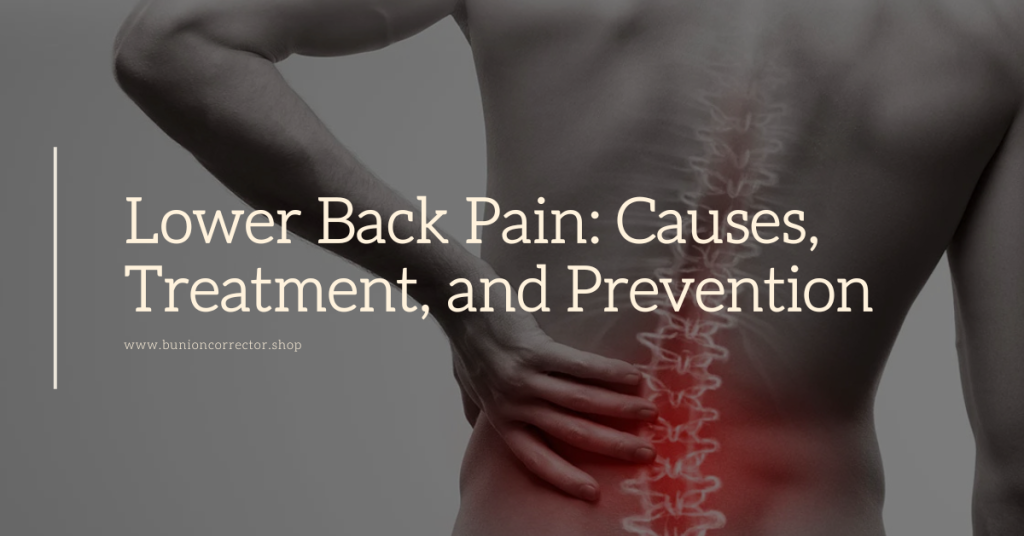Lower back pain is a common problem that affects millions of people worldwide. Whether it’s due to sitting too long, lifting heavy objects, or simply a part of aging, lower back pain can range from mild discomfort to debilitating pain. While it’s often temporary, it can become chronic for some people, making everyday activities difficult. In this blog post, we’ll explore the causes of lower back pain, ways to treat it, and how to prevent it from happening in the future.

What is Lower Back Pain?
Lower back pain is felt between your lower ribs and the top of your legs. This area, known as the lumbar region, supports much of your body’s weight and is highly susceptible to strain and injury. Lower back pain can be dull and aching or sharp and intense, depending on its cause. It can also come on suddenly (acute) or be a persistent problem (chronic).
Symptoms of Lower Back Pain
Before diving into the causes and treatments, it’s essential to recognize the symptoms of lower back pain. Here are some common signs to look out for:
- A dull, aching pain in the lower back
- Sharp, shooting pain that radiates down your legs (sciatica)
- Muscle spasms or stiffness in the lower back
- Difficulty standing, walking, or bending over
- Pain that worsens after prolonged sitting or standing
If you experience any of these symptoms, it’s a sign that your lower back needs attention.
Causes of Lower Back Pain
There are many potential causes of lower back pain, and sometimes, it can be hard to pinpoint the exact reason. However, here are some common causes that might be contributing to your discomfort:
- Muscle or Ligament Strain
Muscle or ligament strain is one of the most frequent causes of lower back pain. This often occurs after lifting something too heavy, twisting awkwardly, or sudden movements. Muscle strain can also result from poor posture or sitting in one position for too long.
- Herniated or Slipped Disc
Your spine comprises small bones (vertebrae) cushioned by discs that act like shock absorbers. Sometimes, these discs can bulge out or break open, causing a herniated or slipped disc. This condition can press on nearby nerves, leading to lower back pain or sciatica.
- Arthritis
Osteoarthritis is another common cause of lower back pain, especially in older adults. This degenerative condition leads to the breakdown of cartilage in the spine, causing pain and stiffness. It may also cause the space around the spinal cord (spinal stenosis) to narrow, which puts pressure on the nerves.
- Skeletal Irregularities
Conditions like scoliosis, where the spine curves abnormally, can cause lower back pain. Other issues, such as poor spine alignment or abnormal walking patterns, can contribute to back discomfort.
- Osteoporosis
Osteoporosis weakens the bones and makes them more prone to fractures. If the vertebrae in your spine are weakened by osteoporosis, it can lead to pain in the lower back.
Treating Lower Back Pain
Fortunately, several treatments are available for lower back pain, depending on its severity and cause. Here are some approaches that may help alleviate your pain:
1. Rest and Gentle Movement
While bed rest used to be a standard prescription for back pain, we now know that too much rest can make the problem worse. Instead, staying as active as possible without worsening your pain is best. Gentle stretches and low-impact activities like walking or swimming can help keep your muscles strong and flexible.
2. Over-the-Counter Pain Relievers
Medications like ibuprofen (Advil) or acetaminophen (Tylenol) can help manage mild to moderate lower back pain. These medications reduce inflammation and help control pain, making it easier to stay active.
3. Hot and Cold Therapy
Applying heat or ice to your lower back can provide relief. Ice can help reduce inflammation in the early stages of injury, while heat can relax tight muscles and promote blood flow, aiding the healing process.
4. Physical Therapy
A physical therapist can teach you specific exercises to strengthen your core and back muscles, improving your posture and mobility. They can also help you learn better ways to move and sit to avoid further strain on your back.
5. Chiropractic Care
Chiropractic adjustments may offer relief for some people with lower back pain, especially if the pain is related to alignment issues in the spine. Always ensure that you see a licensed chiropractor for any treatment.
6. Massage Therapy
Massage therapy can help relax tight muscles, improve circulation, and alleviate tension in the lower back. It’s especially beneficial for people with muscle strains or spasms contributing to their pain.
7. Injections and Surgery
In more severe cases, injections of corticosteroids around the spine may help reduce inflammation and pain. If conservative treatments don’t provide relief, surgery might be considered, particularly in cases of herniated discs or spinal stenosis.

Preventing Lower Back Pain
While some causes of lower back pain, such as aging or genetics, can’t be prevented, there are several steps you can take to reduce your risk of developing it.
- Maintain a Healthy Weight
Excess weight, especially around the abdomen, puts additional strain on your back. Maintaining a healthy weight can reduce the pressure on your spine and prevent future episodes of lower back pain.
- Exercise Regularly
Regular physical activity, especially exercises that strengthen the core (your abdominal and back muscles), can help protect your back from injury. Activities like yoga, Pilates, and swimming improve flexibility and strength.
- Practice Good Posture
Whether sitting at your desk, standing in line, or lifting heavy objects, practicing good posture can help prevent back strain. Try to sit up straight with your shoulders relaxed and avoid slouching. When lifting, bend at your knees instead of your waist and keep the object close to your body.
- Invest in a Good Mattress
A supportive mattress can make a world of difference for your back health. Look for a mattress that provides the right balance of firmness and comfort, and ensure it supports your spine in a neutral position while you sleep.
- Take Breaks and Stretch
If you spend long periods sitting, take breaks every hour to stand up, walk around, and stretch your back and legs. This helps reduce tension in your muscles and improves circulation.
When to See a Doctor
While lower back pain is often temporary and can be managed with home treatments, you should see a doctor if:
- Your pain lasts more than a few weeks
- It’s accompanied by leg numbness, weakness, or tingling
- You experience sudden weight loss or fever
- The pain is severe and doesn’t improve with rest or medication
A healthcare professional can help determine the underlying cause in these cases and provide appropriate treatment.
Conclusion
Lower back pain is prevalent, but it doesn’t have to control your life. By understanding the causes, adopting proper treatment methods, and taking preventative measures, you can manage and even prevent lower back pain from becoming a chronic issue. Remember, taking care of your body now can save you from discomfort in the future!